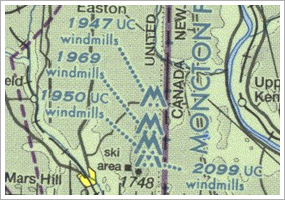| The following stories from the June 19, 2009, edition of AOPA ePilot were provided to AOPA members who expressed an interest in the particular subject areas. Any AOPA member can receive information tailored to their areas of interest by updating their preferences online. - My ePilot -- Turbine Interest -Hawker Beechcraft sets new initiativesHawker Beechcraft Corporation now sells its 451-knot Premier IA light business twinjet with free maintenance for five years or 1,000 hours—whichever comes first. The zero-cost maintenance deal is available until Sept. 30. Hawker Beechcraft has also begun a Safety Management System (SMS), a program of continuous improvement in personal, product, and process safety. Read more >> TRAINING TIPsWind-turbine hazards
This is not the first time that technological innovation has brought a new type of obstruction to the aviation scene. Pilots flying in recent years know that communications towers have frequently appeared in areas that had been obstruction-free. Now, wind turbines are making their appearance in high places as entrepreneurs strive to provide alternative means of power generation. The arrays of large windmills—literally towering hundreds of feet above the terrain—are impressive to behold, even when still under construction. See a description of turbines’ visual impact in the feature " Chris and Dan’s excellent adventure."
But it’s also critical to know their location and their vertical and horizontal extent, as the accompanying sectional chart excerpt in the vicinity of Mars Hill, Maine, clearly illustrates. Note that the wind farm is located just east of the Class E corridor associated with Northern Maine Regional Airport, and protrudes vertically approximately 400 feet above the airport’s 1,500-foot-msl traffic pattern.
Remember that the symbol “UC” next to an obstruction shown on an aeronautical chart signifies that the hazard is still under construction. So study the newest edition of your sectional chart carefully, and then expect rapid changes on the ground where wind power projects are under way. TRAINING PRODUCTSAV8OR gets fuel, airport infoThe AV8OR handheld GPS from Bendix/King by Honeywell is now available with fuel price and airport information from Airguide Publications’ Flight Guide. Restaurant, hotel, taxi, and discount information is included in the package, along with daily fuel price updates. The upgrade is part of a package that sells for a $99 annual fee. The AV8OR retails for $799 and is sold through authorized dealers; see the Web site for more information. |
 Visualize an entirely new class of aeronautical obstructions springing up across the landscape—and sometimes even on the waters. These new hazards may sit on the highest ground for miles around. They can be found near airports, as well as on remote ridges. They occur in small groups, or in large clusters or “farms.” It’s not uncommon for them to touch traffic pattern height or better. For low-flying visual pilots, especially those arriving at airports under marginal conditions, it is imperative to know just where these wind-turbine hazards are and how many of them are arranged across the terrain.
Visualize an entirely new class of aeronautical obstructions springing up across the landscape—and sometimes even on the waters. These new hazards may sit on the highest ground for miles around. They can be found near airports, as well as on remote ridges. They occur in small groups, or in large clusters or “farms.” It’s not uncommon for them to touch traffic pattern height or better. For low-flying visual pilots, especially those arriving at airports under marginal conditions, it is imperative to know just where these wind-turbine hazards are and how many of them are arranged across the terrain.

